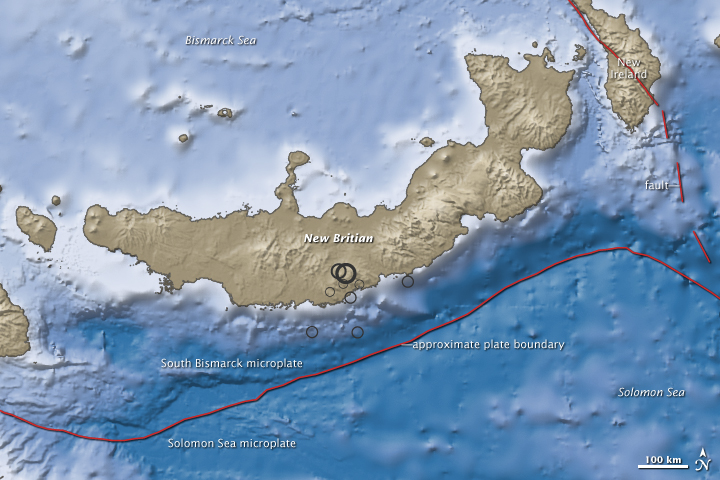


Multiple earthquakes occurred in the region of Papua New Guinea’s New Britain on July 18–19, 2010, according to the U.S. Geological Survey (USGS). The two largest quakes had magnitudes of 7.3 and 6.9. This color-coded map shows the topography, bathymetry, fault lines, and earthquake locations for the region.
In water and on land, colors lighten with height, so shallow depths and high peaks are pale. Faults and approximate plate boundaries appear as red lines. Circles indicate earthquakes, and larger circles with thicker borders indicate greater magnitudes. The two largest quakes appear very close to each other.
According to the USGS summary of the event, the 7.3-magnitude quake on July 18 likely resulted from thrust faulting on or near the boundary between two microplates: the Solomon Sea Plate and the South Bismarck Plate. Where the earthquake occurred, the Solomon Sea Plate grinds roughly northward in relation to the South Bismarck Plate at about 120 millimeters (a little less than 5 inches) per year. The Solomon Plate pushes under the Bismarck Plate and dips to the north-northwest.
The USGS reported that the 7.3 quake occurred roughly 10 kilometers (6 miles) to the north and 30 minutes after a 6.9-magnitude quake. The foreshock occurred at a greater depth and resulted from reverse faulting. The USGS indicated that the 6.9 quake likely occurred within the subducting Solomon Sea Plate.
The New Britain region is seismically active and experiences both earthquakes and frequent volcanic activity.
NASA Earth Observatory image created by Jesse Allen, using earthquake and plate tectonics data from the USGS Earthquake Hazard Program, elevation data from the Shuttle Radar Topography Mission (SRTM) provided by the University of Maryland’s Global Land Cover Facility, and ocean bathymetry data from the British Oceanographic Data Center’s Global Bathmetric Chart of the Oceans (GEBCO). Caption by Michon Scott.